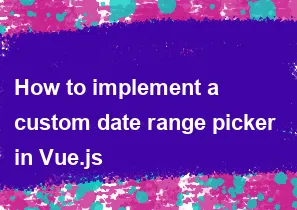How to implement a custom date range picker in Vue.js

Implementing a custom date range picker in Vue.js can be achieved by creating a reusable component that provides the functionality you need. Here's a step-by-step guide to create a simple custom date range picker:
- Create a Vue Component: Start by creating a Vue component for your date range picker. You can do this in a separate file or within your existing Vue project.
javascript// CustomDateRangePicker.vue
<template>
<div>
<input type="text" v-model="startDate" @click="openPicker('start')" placeholder="Start Date">
<input type="text" v-model="endDate" @click="openPicker('end')" placeholder="End Date">
<div v-if="showPicker">
<!-- Date picker UI goes here -->
</div>
</div>
</template>
<script>
export default {
data() {
return {
startDate: '',
endDate: '',
showPicker: false
}
},
methods: {
openPicker(type) {
// Logic to show your custom date picker
// You can use libraries like Flatpickr or create your own
}
}
}
</script>
<style>
/* Add custom styles for your date range picker */
</style>
Implement Date Picker Logic: You need to implement the logic to display the date picker when the input field is clicked. You can use a library like Flatpickr or build your own date picker component.
Handle Date Selection: Once the user selects the dates, update the
startDateandendDatedata properties accordingly.Use the Component: Finally, use your custom date range picker component in your Vue application.
javascript<template>
<div>
<custom-date-range-picker @date-range-selected="handleDateRangeSelected" />
</div>
</template>
<script>
import CustomDateRangePicker from './CustomDateRangePicker.vue';
export default {
components: {
CustomDateRangePicker
},
methods: {
handleDateRangeSelected({ startDate, endDate }) {
// Handle selected date range
}
}
}
</script>
Remember to add necessary styling and functionality to make your date range picker user-friendly and visually appealing. You can enhance it further by adding features like date validation, preset date ranges, etc., based on your requirements.
-
Popular Post
- How to optimize for Google's About This Result feature for local businesses
- How to implement multi-language support in an Express.js application
- How to handle and optimize for changes in mobile search behavior
- How to handle CORS in a Node.js application
- How to use Vue.js with a UI framework (e.g., Vuetify, Element UI)
- How to configure Laravel Telescope for monitoring and profiling API requests
- How to create a command-line tool using the Commander.js library in Node.js
- How to implement code splitting in a React.js application
- How to use the AWS SDK for Node.js to interact with various AWS services
- How to use the Node.js Stream API for efficient data processing
- How to implement a cookie parser middleware in Node.js
- How to implement WebSockets for real-time communication in React
-
Latest Post
- How to implement a dynamic form with dynamic field styling based on user input in Next.js
- How to create a custom hook for handling user interactions with the browser's device motion in Next.js
- How to create a custom hook for handling user interactions with the browser's battery status in Next.js
- How to implement a dynamic form with dynamic field visibility based on user input in Next.js
- How to implement a dynamic form with real-time collaboration features in Next.js
- How to create a custom hook for handling user interactions with the browser's media devices in Next.js
- How to use the useSWRInfinite hook for paginating data with a custom loading indicator in Next.js
- How to create a custom hook for handling user interactions with the browser's network status in Next.js
- How to create a custom hook for handling user interactions with the browser's location in Next.js
- How to implement a dynamic form with multi-language support in Next.js
- How to create a custom hook for handling user interactions with the browser's ambient light sensor in Next.js
- How to use the useHover hook for creating interactive image zoom effects in Next.js